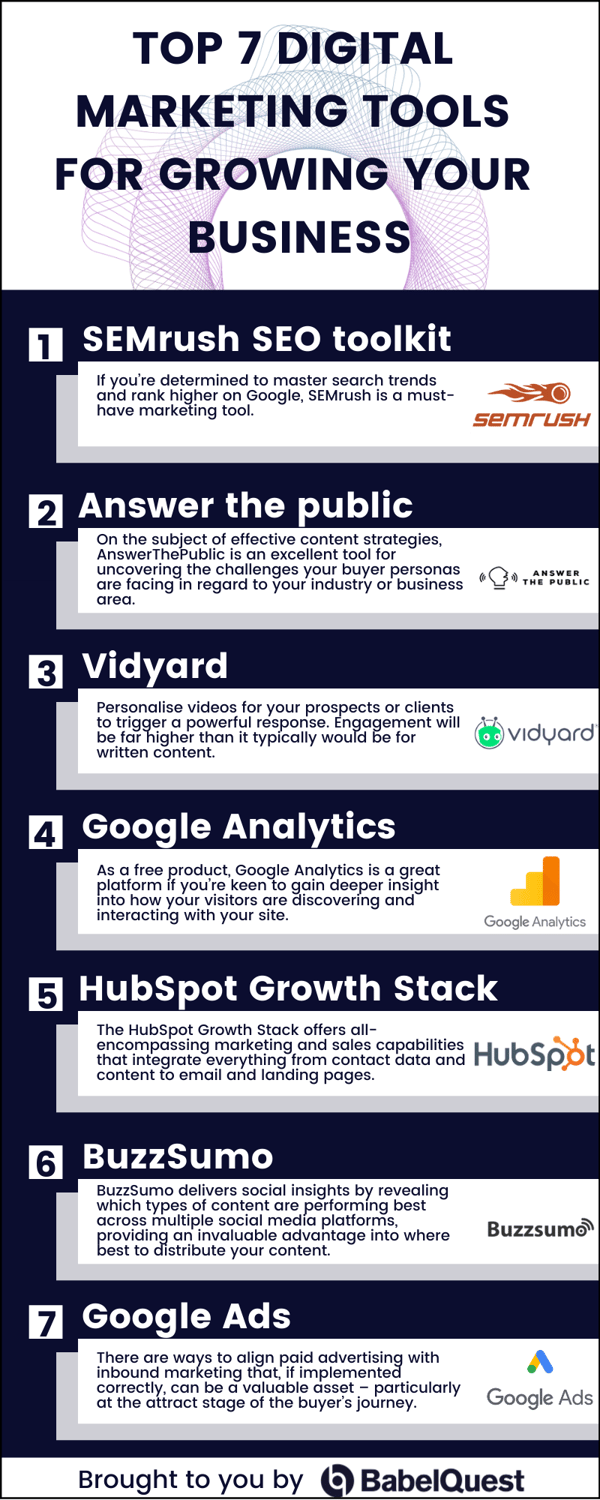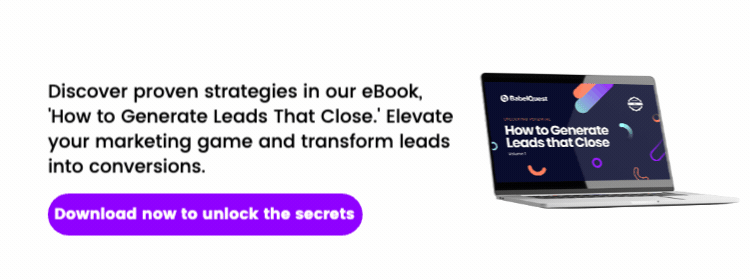The best inbound marketing tools can do wonders for your brand campaigns — but only if you know which ones to utilise and invest in.
With thousands of apps, platforms, and other tools clamouring for the top spot, it can be difficult knowing which ones to work with, never mind how far the wrong choice could set you back — in time and budget.
To help you make the right choice, we’ve put together a list of the top seven best inbound marketing tools you could be using to improve your campaign performance, generate leads that close, and grow better.


1. Strengthen your organic presence with SEMrush SEO Toolkit
Business growth and the ability to scale your inbound marketing depend on a predictable, repeatable revenue flow.
Key to achieving this is a core foundation of topic clusters that rank well for your areas of expertise.
'SEMrush has a whole suite of reliable search marketing analysis tools. I love using its keyword analysis capabilities, but it's most famous for its competitor intelligence', explains SEO and content strategy consultant Charlie Williams. 'With this, you can quickly see the search queries and topics your competition are targeting, both organically and with PPC. That gives you an insight into the potential search market and plenty of ideas of how to improve your content marketing strategy and performance.'
"You can also use it as a home for your campaign thanks to the keyword tracking and integration with Search Console and Google Analytics."
We use SEMrush every day to monitor our clients’ share of keyword real estate and iterate their inbound campaigns accordingly to maximise the impact of our activity. If you’re determined to master search trends and rank higher on Google, SEMrush is a must-have marketing tool.
2. Discover your buyers’ problems using AnswerThePublic
On the subject of effective content strategies, AnswerThePublic is an excellent tool for uncovering the challenges your buyer personas are facing in regard to your industry or business area.
It achieves this by gathering and presenting you with all the data it finds online on the questions around your chosen search term. In doing so it gives you clean, easy-to-identify insights into what kinds of problems your audience is facing, how they feel about a subject, and what kind of solutions they’re looking for.
Best of all, it’s free and takes seconds to get started. Try AnswerThePublic out now.
3. Click play on Vidyard to engage your prospects
50% of your content should be in video’, HubSpot director and all-round growth aficionado Dan Tyre stated at The Revenue Growth Summit last week. Co-founder and CEO of Vidyard Michael Litt echoed these sentiments in his session on video marketing when he revealed that 90% of customers say video helps them to make buying decisions. ‘Video is the most desired channel for sales roles.'
Personalise videos for your prospects or clients to trigger a powerful response. Engagement will be far higher than it typically would be for written content.
He went on to add: ‘Use Vidyard to receive alerts and know who’s watching your videos, which video, and for how long. You could even use a short video to serve as a reminder of a meeting or encourage a next-step and reduce your drop-off rate.’
4. Monitor your site’s performance using Google Analytics
Data tracking sits at the core of every digital marketing campaign. If you don’t already recognise this, you’ve got bigger problems that you need to address — read this article on the importance of performance analysis now.
If you already recognise the crucial role that data tracking plays in your campaign’s performance but you know you could be tracking and monitoring that data better, Google Analytics is your friend.
‘We use Google’s world-renowned analytics platform alongside HubSpot to reveal a broad scope of digital insights for our clients’ campaigns’, said Gem Latimer, our inbound strategist. ‘From how many new visitors view a site and how many are returning visitors to which website pages are most viewed, use these metrics to iterate campaign performance, report on key results, and prioritise future activity.’
As a free product, it’s a great level platform if you’re keen to gain deeper insight into how your visitors are discovering and interacting with your site. The dashboards can be somewhat inaccessible at first, but invest time into the platform and you’ll quickly find your way around.
5. Drive repeatable, scalable revenue using the HubSpot Growth Stack
Growing in a scalable way requires full visibility of ROMI, enabling you to make effective sales and marketing investment decisions with confidence. Key to calculating the return on your marketing investments is your ability to track the total cost of customer acquisition (COCA). This means end-to-end visibility of your customer’s journey, from the first touch to deal closed. Cue HubSpot.
The HubSpot Growth Stack offers all-encompassing marketing and sales capabilities that integrate everything from contacts data and contents to emails and landing pages.
There’s no need to go it alone. Discover how you could benefit from buying HubSpot through a partner agency.
6. Gain a competitive edge with BuzzSumo
Across industries, the digital marketplace is crowded. Key to standing out in the search engine results pages (SERPS) and across social media channels is insights into what activity your competitors are prioritising and how effective that activity is.
BuzzSumo delivers these insights by revealing which types of content are performing best across multiple social media platforms, providing an invaluable advantage into where is best to distribute your content to engage prospects.
This handy marketing tool also provides you with industry benchmarks to strive for when promoting your content.
If you’re relatively new to content creation, these content marketing tips will be useful.
7. Dominate page one of the SERPs with Google Ads
When looking to grow sustainable revenue, you might not immediately consider paid approaches, and you certainly don’t want to rely on them. But there are ways to align paid advertising with inbound, and if implemented it can be a valuable asset, particularly at the attract stage of the buyer’s journey.
There are two forms of paid advertising that lend themselves particularly well to this: Google Ads, where you bid for position 0 in Google’s SERPs, and sponsored posts, which sit natively within social media feeds alongside content viewers have already chosen to see.
With both of these forms of advertising, the paid element is simply expanding the reach of your content in a targeted way that makes sense for the customer, rather than just those footing the bill.
Driving growth with the best inbound marketing tools
There’s no need to jump in headfirst with all of these tools, but by reviewing your goals and the weaknesses in your strategy, we hope you can select the right one to help you elevate your campaign’s performance and drive better growth.
When considering which tools to use, remember that data is key. The greater the visibility you have over how visitors interact with your website and social media, the more equipped you’ll be to make informed marketing and sales decisions that drive further engagement. This means choosing integrated marketing tools that share crucial data by speaking to each other. The right marketing software ultimately help to facilitate this, giving you visibility over data trails and how to grow your business.
Learn how you can use HubSpot to generate leads that close and drive repeatable, scalable revenue growth in our ebook. Download now.
Heading
Separated they live in Bookmarksgrove right at the coast of the famous Semantics, large language ocean and many more stuff and more more more


Tom is BabelQuest's Principal Copywriter. He has a PhD in Creative Writing from the University of Southampton and is a novelist with Sparkling Books.
![7 Best Inbound Marketing Tools for Growing Your Business [Infographic] 7 Best Inbound Marketing Tools for Growing Your Business [Infographic]](https://www.babelquest.co.uk/hs-fs/hubfs/carlos-muza-84523-unsplash-066708-edited.jpg?width=800&name=carlos-muza-84523-unsplash-066708-edited.jpg)


.png?width=50)

.png?width=50)
.png?width=50)


































